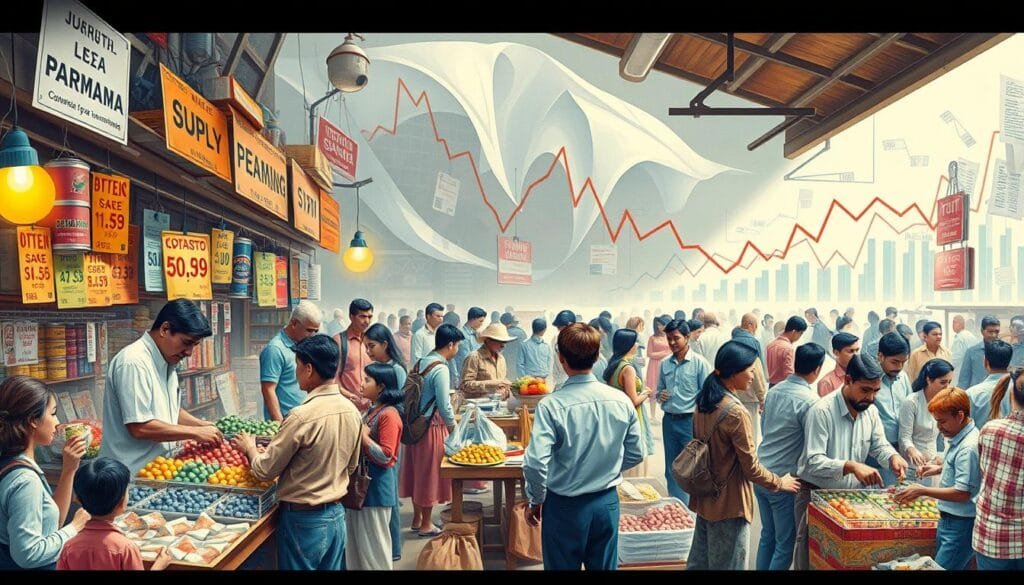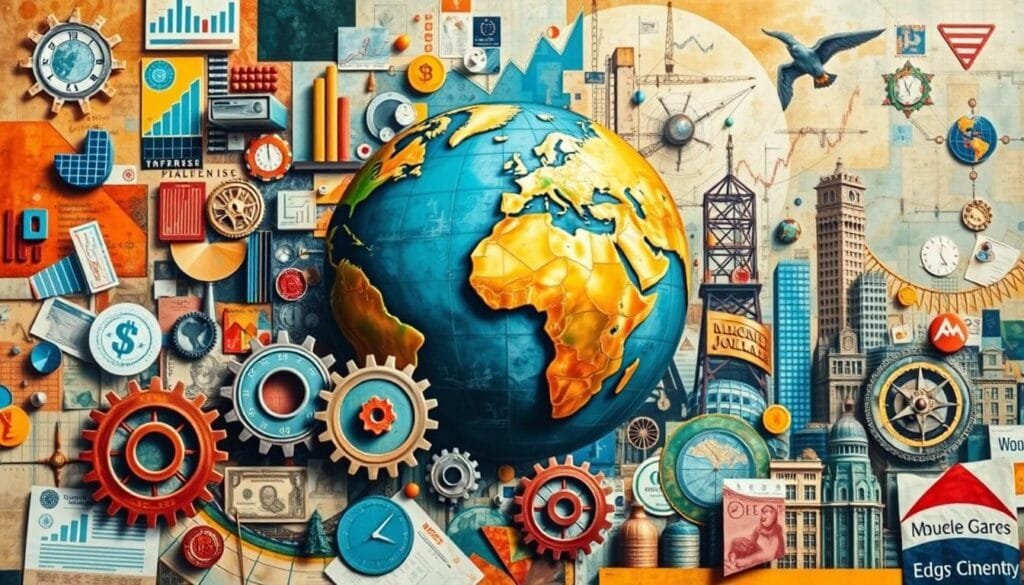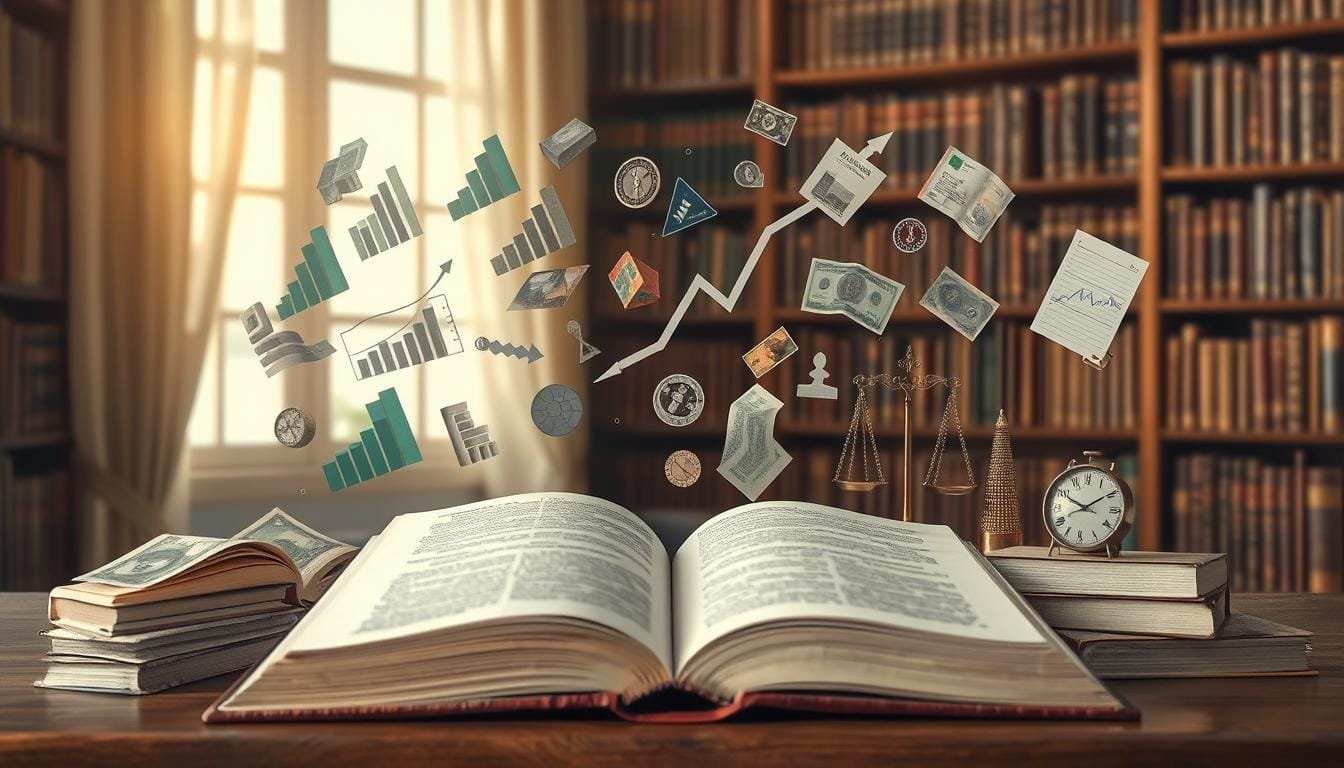To really get economics, we need to demystify economic jargon and grasp economic concepts. This helps us reach economic literacy. Economics shows us how scarce resources are managed. They’re used for making things, consuming, and benefiting society.
Looking at individual choices in microeconomics or big trends in nations via macroeconomics is key. Understanding these helps us see how to be efficient. It also helps us grasp important figures like the GDP and CPI. Economics might seem hard, but it gets easier and can even feel natural with the right guide.
Key Takeaways
- Economics is a gateway to understanding how scarce resources are allocated in society.
- Microeconomics and macroeconomics are two facets that provide insights from individual to national levels.
- Being literate in economic terms allows for better decision-making in personal and business affairs.
- Key indicators such as GDP and CPI are essential for interpreting the economic environment.
- Building economic literacy paves the way for informed participation in political and business discussions.
Economics: A Simplified Introduction
Economics blends social science with real-world policy, making it captivating. It shows how societies use scarce resources to make and share goods.
We learn to navigate the global market by understanding these principles. Economics ties together theory and real-life scenarios.
Microeconomics and macroeconomics are at economics’ core, each examining different scales. Microeconomics delves into personal and business choices. It explores what drives consumer behavior and business operations. Macroeconomics looks at the economy on a larger scale, including inflation and growth. It gives us a full picture of the economy.
Economic theory provides insights from the past and is relevant today. It highlights the role of economic policies and cycles. By learning about supply and demand, we can predict trends and make smart business or policy decisions.
This illustrative table shows key points in micro and macroeconomics:
| Focus Area | Microeconomic Aspects | Macroeconomic Aspects |
|---|---|---|
| Key Concepts | Price determination, Consumer behavior, Firm production, Market structure | National income, Inflation rates, Employment statistics, Economic growth |
| Applied Principles | Law of Supply and Demand, Market Equilibrium, Elasticity | Monetary policies, Fiscal policies, International trade, Economic cycles |
| Practical Implications | Business decision making, Marketing strategies, Resource allocation | Economic forecasting, Policy formulation, Global economic strategies |
| Economic Efficiency | Optimal production and competitive markets | Balance of trade, Optimal resource utilization, Sustainable growth |
Economics helps us understand complex issues like food safety and labor markets. It aims for efficient resource use. By mastering micro and macro aspects, we make better decisions. These decisions can improve societies and the entire global economy.
Economics is a rich field that explains how economic systems work. It also shows their effects on society. As we learn more, we can tackle the challenges of distributing resources and sustainable development.
The Role of Microeconomics in Understanding Individual Behavior
Microeconomic theory is a key tool for analyzing choices individuals make. It examines how changes in resources, market actions, and prices affect decisions. This understanding uncovers the complex nature of consumer actions and pricing. It greatly influences decisions made by companies and governments.
Key Principles of Microeconomics
Microeconomics looks at interactions between buyers and sellers in markets. It studies supply and demand closely. One main idea is the theory of utility. This theory suggests people aim to get the most satisfaction from their resources, considering their limits. It shows how consumers respond to pricing and availability changes.
Also, microeconomics explores how companies adjust their production to economic signals. This helps them achieve balance in the market.
How Demand and Supply Influence Market Outcomes
Microeconomics teaches us that demand and supply set prices and influence market behavior. In perfect competition, the price is determined by how much people want to buy and sell. Market balance is achieved when desired purchases match available sales.
Understanding Consumer Choice and Production Costs
Consumers make choices based on prices and what they prefer. These choices affect their purchase patterns and determine production costs for companies. How consumers adjust to price changes or new product availability shows economic responsiveness. Analyzing these decisions is crucial for pricing strategies in microeconomic studies.

Microeconomics has a wide impact on how individuals behave. Look at this detailed table to see how different factors influence choices:
| Concept | Impact on Individual Behavior | Examples |
|---|---|---|
| Utility Maximization | Influences consumer choices and preferences | Choosing between different bundles of goods to maximize satisfaction within budget limits |
| Price Elasticity | Determines consumer price sensitivity | Reaction to price changes in essential vs. luxury goods |
| Production Costs | Affects supply decisions and pricing | Decision-making in businesses regarding scaling production up or down |
Using microeconomic principles helps individuals and businesses navigate market challenges. This ensures informed decisions that align with economic realities.
Exploring Macroeconomics: The Big Picture
To understand the huge subject of macroeconomics, we need to look closely at how it guides big economic choices. It covers important things like how to check if an economy is healthy, trends in the economy, and how government spending and lending rules shape the economy.
How Economic Indicators Reflect the Health of an Economy
Economic indicators help tell us how healthy an economy is. Experts look at things like inflation, GDP growth, and job numbers. They create detailed reports on these signs. This helps us understand the economy’s growth phase and pinpoint issues like inflation and job concerns.
The Importance of GDP, Unemployment, and Inflation Rates
GDP is very important because it shows the value of all goods and services made in a country over a certain time. It helps us see how the economy is doing overall. On the other hand, looking at job market trends tells us about the economy’s stability and people’s wellbeing. Inflation rates are also key because they affect how much buying power people have and influence government policy on money.
The Influence of Government Policy on Economic Stability
Government actions have a big impact on whether an economy is stable or not. Government spending and taxes directly change how much demand there is in the economy. National banks control the supply of money and interest rates to keep inflation in check and the currency stable. Good policies help manage economic growth and challenges effectively.

Having a strong mix of GDP focus, government spending, and money policies, along with ongoing regulation, is key to a sound economy. Adopting these approaches helps countries avoid economic problems and promote steady growth across different areas.
A person who makes things economic terms
Creators crafting items and services often find economic terms challenging. Learning these terms makes daily tasks easier and guards against market changes. Knowing how to understand economic language aids in setting prices, gauging market demand, and controlling costs.
For individuals creating products, mastering economic terminology for creators can change the game. This knowledge helps them move through the market more skillfully. For example, learning about ‘elasticity’ lets them see how price changes might affect product demand.
| Economic Concept | Relevance to Creators | Impact Example |
|---|---|---|
| Market Demand | Understanding consumer behavior | Adjusting product features based on trends |
| Production Costs | Optimization of resource allocation | Lower costs leading to competitive pricing |
| Pricing Strategies | Maximizing profit margins | Choosing between penetration or skimming strategies |
Understanding the role of agents shapes decisions in the market. Whether buying, selling, or setting prices, knowing these roles can change how one deals with the economy. Learning more economic terms, like those from behavioral economics, helps predict and use consumer trends beyond simple models.
With new economic concepts emerging, it’s vital to stay informed. These theories are key in crafting products, marketing, and planning for the future. They show a dedication to understanding economic terms, improving business strength.
In sum, for creators, diving into economic language isn’t just about the terms. It’s about seeing things differently, with insights into economics. This approach helps ensure their work is not only artistic but also ready for the market and financially sound.
Deciphering Common Economic Systems and Theories
Understanding economic systems and their theories is key to knowing how countries handle their economies. We compare and analyze major economic ideas, focusing on capitalism and socialism, and the concepts of Keynesian and supply-side economics.
Capitalism vs. Socialism: A Comparative Overview
Capitalism and socialism differ in how they manage the economy. Capitalism relies on the market to allocate resources with little government influence. It supports private ownership and business as main growth elements. On the other hand, socialism uses more government control. The state often owns or controls production and distribution under socialism.
These capitalism and socialism differences deeply affect countries’ economic, social, and political scenes.
The table below shows important features of both systems:
| Economic System | Ownership of Resources | Decision Making | Role of Government |
|---|---|---|---|
| Capitalism | Private | Market-based | Limited |
| Socialism | State | Centrally planned | Extensive |
Keynesian Economics and Its Impact on Policy Making
Keynesian theory supports economic intervention during downturns. It says that with counter-cyclical policies, like more government spending and tax breaks, we can boost demand and recover the economy. This idea has greatly affected global economic policies, leading nations to take active roles in facing economic downturns.
Understanding the Basics of Supply-Side Economics
Supply-side economics is all about improving production through lower taxes and less regulation. Its supporters believe that these economic growth strategies create a perfect setting for investment and new ideas, improving the economy. Tax policy implications are crucial as they impact business expansion and job creation, affecting the economy widely.

Exploring these economic systems and theories shows their impact on not just the economy but also societal issues. Conversations about these ideas are vital as they relate to global challenges and the daily decisions that affect economies around the world.
How Economic Indicators Can Guide Personal and Business Decisions
Understanding economic indicators is key for anyone interested in making smart money choices today. They help make sense of complex topics like GDP and CPI. They also shed light on job market trends and employment, which are vital for predicting economic shifts.
The impact of interest rates on the economy is huge. It affects how people save and decide to invest their money. Knowing about interest rates can help you make better financial plans. This knowledge can lead to smarter choices that improve your financial well-being.
Using GDP and CPI to Make Informed Financial Choices
GDP and CPI give us a clear view of the economy’s condition and price changes. If GDP is up, it might be a great time to grow your business or invest more money. On the other hand, understanding CPI can help you tweak your budget to fight inflation.
The Role of Employment Data in Predicting Economic Trends
Checking on job data like unemployment rates can hint at the economy’s future direction. A falling unemployment rate may point to a growing economy. That could be your cue to invest in more staff. But if unemployment is rising, the economy might be slowing down.
The Impact of Interest Rates on Saving and Investing
Interest rates change how we save and invest. Low rates often lead to more borrowing and investing, which businesses love. High interest rates, however, can make saving more appealing. This could slow down spending and investment.
By keeping an eye on these economic indicators, we can make wise, informed financial decisions. Acting on this data helps us align with the broader economy. This approach aims at achieving better stability and success.
Conclusion
Our journey through economics has taken us deep into its core concepts. We’ve looked at micro and macroeconomics, the foundation of financial understanding. Along the way, we’ve discovered key insights into how things are made, shared, and used. Figures like Adam Smith and Lionel Robbins have guided us. They show how scarcity, choices, and outcomes interconnect in our economy.
We also explored how economics ties into politics and even happiness. Questions led us to diverse economic thoughts. Diane Coyle spoke of economics as an evolving conversation on an EconTalk podcast. Contributions from experts like Richard McKenzie and James Otteson keep it lively. Debates, as discussed by David Henderson and Russ Roberts, push our understanding forward, with voices like Max Borders focusing on language’s role in economics.
Experts like Ha-Joon Chang remind us to view economics from different angles. It’s more than theory; it’s tools for making smart choices in life and society. By understanding the various economic theories and indicators, we navigate the financial world more wisely. This knowledge helps us seize life’s opportunities with confidence and make wiser decisions.
FAQ
What are the basics of economics?
Economics is a social science that looks at how people, companies, and governments decide to use limited resources. It focuses on supply and demand, prices, and how everyone in the economy interacts.
How can I demystify economic jargon and grasp economic concepts?
Getting to know economic terms and their meanings is the first step. Also, learn the basic ideas and watch how they work in real life. Using learning tools or asking experts can make economics clearer.
What is microeconomics and how does it affect individual behavior?
Microeconomics examines how individuals, households, and businesses make choices. It looks into how they decide on using resources, setting prices, and theories on making goods. Microeconomics helps us understand what informs consumers’ choices, market trends, and how they react to changes.
How do demand and supply dictate market outcomes?
Demand and supply are vital to the market and decide the balance point of it. Their interaction determines the price of goods and services, as well as how many are made. When these factors change, it can cause shifts in prices and how much is available.
Why is macroeconomic analysis important?
Macroeconomic analysis looks at the entire economy using data like GDP, inflation, and job rates. It helps us know how economies are doing, predict trends, and see how government actions affect stability and regulation.
How can a person who makes things benefit from understanding economic terms?
Anyone making products or services can use economic terms to make smarter choices about costs, demand, and pricing. Knowing these terms helps them to compete better in the market.
What are the key differences between capitalism and socialism?
Capitalism is about private ownership and letting the market guide resources. Socialism seeks more control by the government in distributing resources and managing economic activities.
How does Keynesian economics influence government policy?
Keynesian economics promotes government action to fix the economy during tough times. It suggests increasing demand and investment to reduce the impacts of economic downturns.
What is the premise of supply-side economics?
Supply-side economics believes in spurring economic growth by reducing producers’ hindrances like taxes. It says that fewer obstacles will make producers create more, leading to jobs and wealth.
How can GDP and CPI data inform personal and business financial decisions?
GDP measures a country’s total economic output, and CPI looks at inflation through prices of retail goods. Understanding these can guide individuals and companies in making decisions about investing, pricing, and saving.
Why is employment data vital in understanding the economy?
Employment figures give insight into the job market’s state, reflecting the economy’s health. They help forecast economic trends, showing possible growth or decline phases.
How do interest rates affect savings and investments?
Interest rates, crucial for monetary policy, influence how people and businesses behave with their money. High rates may boost savings but lessen borrowing and spending. Low rates can do the opposite, encouraging more investment and spending to grow the economy.
